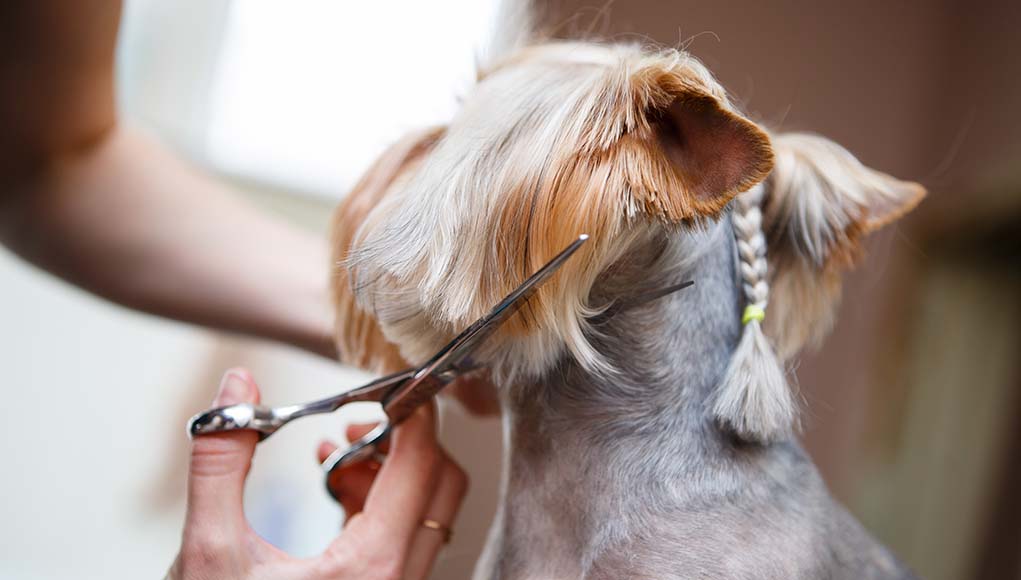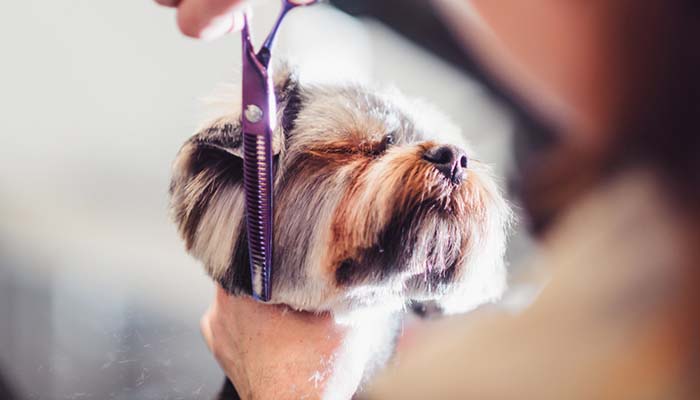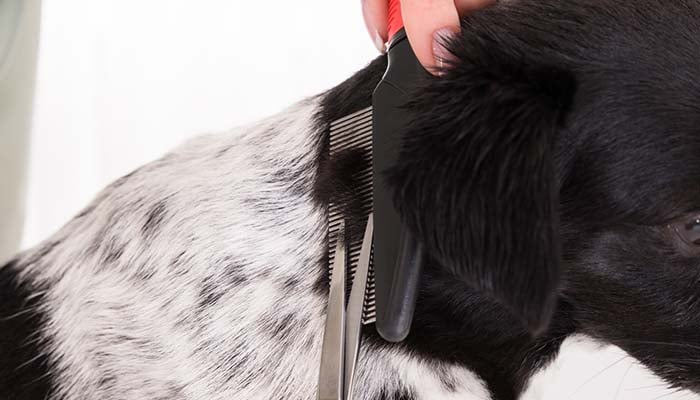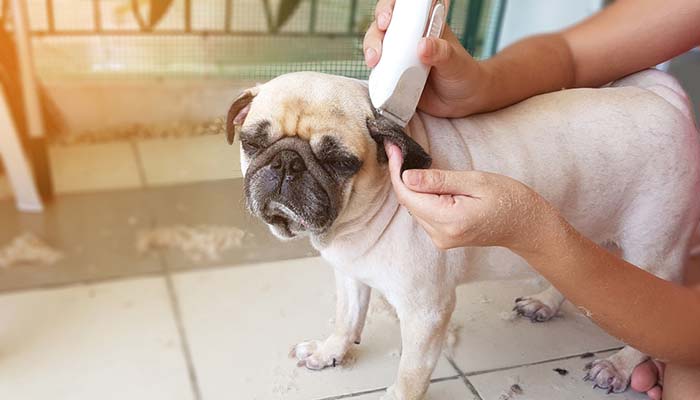Among the many accessories and expenditures our pets require, some parts of grooming a dog may sometimes fall to the wayside. Yet, while not as important as routine vet visits, sufficient amounts of food, monthly preventatives, cutting dog's nails and brushing their teeth, other grooming tasks (such as haircuts) should still be an item accounted for within your pet’s yearly budget.
There are likely several locally and corporately owned businesses in your town or city that offer pet grooming services; a traditional shampoo with attention to the ears, toenail, teeth, and anal glands will typically cost around $50 for most dogs. Some households, though, may not be able to afford to pay someone else to cut hair of their pet, which is when you'll need to learn how to give a dog a haircut from the comfort of your home.
Cutting hair of extremely nervous dogs (or by nervous pet owners), this even may be the most ideal option. Keeping your furry friend in a familiar place while you give them a stylish haircut with your own trusted hands makes for a more comfortable experience.
ALSO READ: How To Use Dog Clippers to Trim or Cut Dog’s Hair
Why Regular Hair Trims Are Important
A soft and clean pet makes for a more pleasing cuddle session on the couch. But more importantly, a serious lack of grooming and trimming of the hair can lead to issues for canines, such as matted hair, skin infections, or pest infestations.
There are many examples of that, but most commonly, it's the abandoned or neglected animals that are surrendered or rescued from unfortunate situations every day, and many of them are discovered to be in such a dire need of grooming that drastic measures must be taken, including amputation (as bulky masses of matted hair can cut off circulation and leave a limb entirely useless).
While it’s unlikely your cared-for pet will ever have to endure a situation like the one described, it hopefully expresses the importance of regularly attending to your pet’s coat.
Haircuts – Not for Every Dog
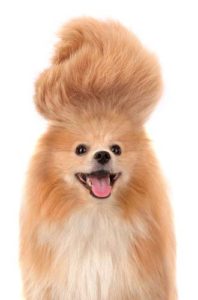 Before picking up shears to give your dog a haircut, there are some important qualifications your pet needs to meet. Avoid cutting your dog’s hair until you learn more about their breed and their coat, especially if your pet’s coat or appearance could be described with any of the following adjectives:
Before picking up shears to give your dog a haircut, there are some important qualifications your pet needs to meet. Avoid cutting your dog’s hair until you learn more about their breed and their coat, especially if your pet’s coat or appearance could be described with any of the following adjectives:
- Shaggy
- Heavy
- Fluffy
- Long
- Thick neck
- Extra-skin
If one or more of the above descriptors describe your canine counterpart, then it’s likely your pet has a double coat. You may be most familiar with double coated dogs as seen in breeds like Huskies, Akitas, and Chow Chows; however, smaller breeds and even breeds with sleek, “unfluffy” fur have double coats too, such as Pomeranians and Beagles.
Double coated breeds should never be shaved, even in hot, humid climates. Their specially-designed coats are essential in regulating their body temperature, be it hot or cold. Shaving off these self-sufficient coats can cause irreparable damage, unless of course the pet in question has a serious case of mange or other skin ailment, in which case you should consult the best steps with a veterinarian. What’s most important for double-coated dogs is that they are regularly brushed; this helps avoid matting which can cause overheating and present an inviting home for common pests.
If you’re unsure if your pet has a double coat, consult your veterinarian or visit a local dog grooming business. If your pet was adopted or rescued and you’re unsure of their pedigree, you should know that even if a dog isn’t a purebred Collie, it’s still likely the mutt may have a double-coat. All this being said, slight trimming is unlikely to cause damage and may even be recommended, particularly around the paws and hind quarters.
RELATED: How to Help Your Dog Get Used to Pet Clippers
Training Your Dog to Enjoy (or Tolerate) Haircuts
The easiest means of training your pooch to enjoy, or at least entertain, haircuts and other grooming regimes, is to start young. The first 12 months of a puppy’s life are highly impressionable and if not properly socialized, behavioral issues, including aggression and anxiety, can develop later in life. If you’re in the position to introduce a grooming routine to your pet while they’re still young, then do so.
The key to raising a dog who can tolerate being touched in sensitive areas is to target those sensitive areas, which for most canines is their paws, ears, and back legs. Routinely play with their paws (gently) and check their ears, you can gingerly run your hand up their back legs. The puppy will slowly become more familiar, and therefore more comfortable, with these sensations, which will also make visits to the vet for yearly examinations much less scary for the dog and much less difficult for the veterinarian technician.
However, if you aren’t in the possession of a puppy, fear not – any dog at any age is trainable. In fact, older dogs, some argue, are more trainable as they lack the hyper, inattentive nature of a young, playful puppy.
As haircuts involve using sharp and sometimes noisy (clippers, blow-dryers, etc.) utensils to get the job done, you’ll find that your pet may not be keen to sit still during their salon treatment. If this is the case, stop what you’re doing immediately. You could very easily give your dog an unwanted complex that involves them running and hiding in any space they can squeeze themselves into as soon as they see a pair of scissors or a brush.
Here are some tips:
1. Take it slow
If your dog fears strangers, it’s likely that you wouldn’t opt to leave them in a crowded plaza on their own. We don’t throw animals into situations as a means to “break” their fear, we ease them into it. If your dog hasn’t experienced a haircut at home with you before, then you should assume they may be fearful of noisy pet hair clippers or big, shiny scissors, even if you don’t know this about them yet.
“Introduce” your pet to your grooming utensils by calmly setting them on the floor in front of your dog. When their curiosity is irked and they approach to venture a tentative sniff or lick, give them praise and treats for their bravery. You may choose to do this several times before actually using the utensils. You’ll know you’ve been successful in introducing them when your pet wags their tail at the very sight of a pair of scissors.
2. Be gentle
It’s easy to become frustrated when our dogs are resistant or not obeying. However, acting on your frustration is likely to only make them more rigid and less permissive. Instead, be as gentle as you can. You may exhibit this by petting them in long, slow strokes, encouraging them in a soft, happy voice, and lifting up their paws and working around their bodies with an ease and respect.
3. Give lots of treats
Delicious morsels of shredded chicken or bits of turkey bacon are likely to highly motivate your scissor-shy pooch. Save these valued treats for grooming sessions only, as it will give them something to look forward to. You can also try to plan your schedule to brush and cut them before you feed them their meal so that they are even more interested in the treats and less interested in the fact that you’re trimming around their tail.
4. Reward good behavior
You can do more than give yummy treats, especially for a dog who is less food-motivated. After a successful grooming session, spend time with your pup and give them lots of attention. A long game of fetch in the backyard, an extra-long belly rub, or a walk to their favorite park are only a few suggestions as to how to reward your furry friend.
5. Enlist help
Not surprisingly, giving a dog a haircut is made a lot easier when you ask for help from a roommate, friend, spouse, or family member. Just be sure it’s someone your pet feels comfortable with, as they’re likely to already be on guard.
RELATED: How to Trim Your Dog’s Face Hair with Scissors
Trimming Techniques: Which One Is Right?
There are two ways to approach a dog haircut – with clippers, or scissors. You can (and depending on the breed/coat, probably need) use the combination of both for the best results. Here are a few things to keep in mind.
Clippers
Given your pet isn’t double-coated, then clippers are probably the best option for haircuts. While you can use human-grade clippers on your dog, you may find that they are not as forgiving as clippers created for canines are, especially if you use professional-grade clippers for cutting dog's hair.
When using clippers, adjust length based on the current length and desired length of your pet’s coat. Run the clippers in the same direction as the hair follicles grow, not against. Be sure to brush your dog before beginning the haircut to rid of nots or tangles.
Scissors
If your pet is double-coated and/or scared of the noise clippers make, then silent clippers that make no noise, which are essentially scissors or shears, may be ideal for you. The goal with scissors is not so much to take off lots of length, but rather to clean up or “tidy” certain areas.
This may be especially important to a breed that has a shaggy coat, resulting in unruly, wispy hairs around the paws or fur hanging down in the face making sight problematic. Use the length of the blade to get desired length, then you may use the tips of the shears, using quick, short snips, to give the cut a less abrupt look, effectively “blending” it into their coat.
When it comes to scissors, consider these varieties:
- Thinning shears
This utensil is designed to protect its user from obvious mistakes, like too huge of a chunk or too large of a cut. The unique teeth on a thinning shear don’t cut in a striking, straight line like the blade of a regular pair of scissors. These are great for any length of texture of fur but will require several snips to gain the desired look. They’re also helpful when breaking up matted coats.
- Curved scissors
These will help the doggie stylist, in this case you, to get in and around the curved, elegant body of your dog. These are particularly helpful around the hind quarters, head and face of a dog.
- Short-bladed scissors
Professionals often utilized long-bladed scissors, but the shorter the blades, the more forgiving the cut. Five to seven-inch scissors may be best, at least, starting out.
Problem Areas to Pay Attention to
There are a few areas where you need to be particularly careful around when trimming your dog's hair – paws, ears, and tail.
Paws
Miniature scissors (designed for sewing or beard trimming) may be best for this venture, especially if you own a puppy or small dog. Petite-sized shears will give you the ability to clip delicately within and around the many small crevices of a paw. Paws, particularly of long-coated canines, are an important task when performing your own grooming routine.
If developed, furry masses growing around the toes, have more probability of picking up foreign items and causing discomfort in the animal, but could also lead to infection. During frigid winters, keeping the paws nice and trimmed will help your pet stay warm (dogs regulate some of their body temperature through their paw pads) by keeping sludge, snow, ice, and sleet from packing onto overgrown paw fur.
Eyes
Wipe around the eyes with a warm, soothing rag, laying down any hair you don’t want to get in the way of your scissors. Using a small comb to help you cut around this sensitive area is extremely helpful and will keep you feeling confident and your dog more relaxed.
Comb the hair out and hold it with the tips of one hand, then with your other hand trim the combed-out hairs. Keeping your dog’s vision clear of extraneous strands will keep them safer and happier, although they may not enjoy the haircut, they’ll thank you later with lots of licks.
Tail
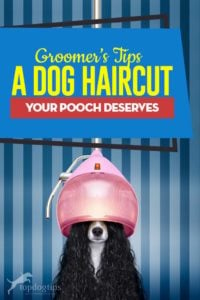 Keeping the hind of a dog well-trimmed and groomed ensures there are no lingering scents or unseemly sights. Additionally, it’ll keep your pet cleaner and less prone to bacterial infections. A clean bottom is less irritated and thus, less likely to be scooted across your new rug.
Keeping the hind of a dog well-trimmed and groomed ensures there are no lingering scents or unseemly sights. Additionally, it’ll keep your pet cleaner and less prone to bacterial infections. A clean bottom is less irritated and thus, less likely to be scooted across your new rug.
Depending on the fluffiness of your dog, you may be able to use clippers to get the bulk of fur around this area and then used curved scissors or trimming shears to get a closer, neater haircut.
READ NEXT: How to Make Bathing a Dog Easier (And Some Unique Tools You Can Use)


